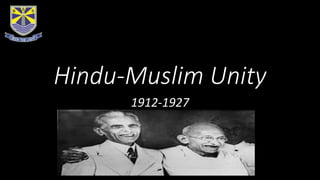
Hindu muslim unity presentation
- 2. Mr. Jinnah as diplomat of Hindu-Muslim unity The most important role which Jinnah played in the politics of India was for the achievement of unity between the Hindus and Muslims by bringing about some understanding between the Indian National Congress and the All India Muslim League. In fact, for more than two decades Jinnah was known more for this role than for any other. Mohammad Ali Jinnah became the architect of Hindu Muslim unity; he was responsible for the Congress-League Pact of 1916, known popularly as Luck now Pact- the only pact ever signed between the two political organizations, the Congress and the All-India Muslim League, representing the two major communities of the subcontinent. On this occasion Mrs. Sarojini Naidu, former President of Indian national congress gave Jinnah, the title of “The Ambassador of Hindu-Muslim Unity”. In 1913, Mr. Jinnah joined the Muslim league.
- 3. THE LUCKNOW PACT, 1916 • The Lucknow Pact was an agreement reached between the Indian National Congress and the Muslim League at a joint session of both the parties held in Luck now in December 1916. Through the pact, the two parties agreed to allow representation to religious minorities in the provincial legislatures. The main features of the Lucknow pact were that the India Council must be abolished. The salaries of the Secretary of State for Indian Affairs should be paid by the British government and not from Indian funds. The executive should be separated from the judiciary. Muslims should be given 1/3 representation in Central Govt.
- 4. The Government of India Act, 1919 • Government of India Act, 1919 also known as Montagu-Chelmsford Reforms which came into force in 1921 . It was instituted in the British Indian polity to introduce the Diarchy, i.e., rule of two which means executive councilors and popular ministers. It was passed to expand participation of Indians in the government of India. The Act embodied the reforms recommended in the report of the Secretary of State for India, Edwin Montagu, and the Viceroy, Lord Chelmsford. The Act covered ten years, from 1919 to 1929. The Indian National Congress and the Muslim League had recently come together demanding self-rule. The 1919 reforms did not satisfy political demands in India. The British repressed opposition, and restrictions on the press and on movement were re-enacted through the Rowlatt Acts introduced in 1919.
- 5. The Rowlatt Act, 1919 • Rowlatt Act was passed in March 1919. The purpose of the act was to curb the growing nationalist upsurge in the country. The act allowed certain political cases to be tried without juries and permitted internment of suspects without trial. Mahatma Gandhi, among other Indian leaders, was extremely critical of the Act and argued that not everyone should be punished in response to isolated political crimes. Mr. Jinnah resigned from the imperial legislative Council in protest against the Rowlatt act.
- 6. The Jallianawala tragedy, 1919 • The Jallianwala Bagh massacre, On 13th April 1919 people gathered at Jallainwala bagh (Amritsar) to protest against the arrest of the two National Leaders of India, i.e, Satya Pal & Dr Saifuddin Kitchlew. The British military officer General Dyer without giving warning to the people ordered his troops to fire the unarmed crowd killing at least 379 people and injuring over 1,000 other people.
- 7. The Khilafat Movement, 1919-24 • The Khilafat movement (1919-1924) was an agitation by Indian Muslims allied with Indian nationalism in the years following World War I , launched by Muslims of British India led by Shaukat Ali, Maulana Mohammad Ali Jauhar, Hakim Ajmal Khan, and Abul Kalam Azad. Its purpose was to pressure the British government to preserve the authority of the Ottoman Sultan as Caliph of Islam followed the breakup of the Ottoman Empire at the end of the war.
- 8. The non-cooperation Movement,1920 • The Non-Cooperation Movement was a significant phase of the Indian independence movement from British rule. It was led by Mahatma Gandhi after the Jallianwala Bagh Massacre. It aimed to resist British rule in India through non-violent means or "satyagraha”. People were asked to resign from their government jobs. People were asked to withdraw their children from government-controlled or aided schools and colleges. People were asked to boycott foreign goods and use only Indian-made goods.
- 9. The Simon Commission, 1927 • The Simon Commission was a group of 7 MPs from Britain who was sent to India in 1928 to study constitutional reforms and make recommendations to the government. It came to be known as the Simon Commission after its chairman Sir John Simon. The Simon Commission was opposed primarily because it did not have any Indian representation in the assemblage. The government of Britain had appointed this Commission in 1927. The goal of the Simon Commission was to give an account of how the Indian constitution was working. The Commission was strongly opposed by many Indians. It was opposed by Nehru, Gandhi, Jinnah, the Muslim League and Indian National Congress because it contained seven members of the British Parliament but no Indians. Indians saw it as a violation to their right of self determination and insult to their self respect. Their slogan was Simon Go back.
- 10. By Shayan shahid